Physical Address
304 North Cardinal St.
Dorchester Center, MA 02124
Aortic aneurysm is defined as a localized dilation of the aorta that is at least 50% greater than that of nondiseased adjacent aorta. In the distal aorta, namely the descending thoracic and thoracoabdominal aorta, most aneurysms form as a result of nonspecific medial degeneration, expansion related to chronic aortic dissection, or the disease processes of connective tissue disorders. Whereas aortic aneurysms may be either fusiform (a symmetrical dilation of the aorta) or saccular (a localized outpouching of the aorta), saccular aneurysms are uncommon in the distal aorta and tend to be associated with infection. False aneurysms (also called pseudoaneurysms) may occur and are caused by a disruption of the aortic layers that then permits leaking blood to be contained by the outermost layer of the aorta and may additionally involve the periaortic tissue. Under such conditions, the aortic wall may become dilated beyond its capacity to expand and subsequently rupture.
Contemporary surgery involves a balanced approach toward maximizing the patient's long-term benefit by replacing as much diseased aorta as possible with the need to limit aortic resection to reduce ischemic and other operative risk. Our contemporary approach to open surgical repair of the descending thoracic and thoracoabdominal aorta is presented in this chapter.
The replacement of aneurysmal sections of the distal aorta built on the successful homograft-replacement repairs of aortic coarctation by Gross and others in the mid-1940s. In 1950, Swan used a homograft to replace an 8-cm section of the descending thoracic aorta in a teenage patient with a coarctation-related aneurysm. However, it remained unclear how patients with degenerative aneurysm, who were typically far older, would respond to aortic clamping, because they tended to lack the extensive collateral circulation present in patients with congenital coarctation. Soon after Swan's initial repair, Lam and Aram attempted to replace a fusiform aneurysm of the descending thoracic aorta with a homograft. Despite the use of a shunt to maintain distal perfusion and of other adjuncts in use in this era, this repair failed because the patient became septic; the authors speculated that a successful repair may necessitate full aneurysm extirpation. In 1953, DeBakey and Cooley were able to successfully “clamp and sew” a homograft replacement of a very large aneurysm of the descending thoracic aorta that impinged on the celiac axis (this would arguably be considered an extent I thoracoabdominal aortic aneurysm [TAAA] repair today). And in 1955, Etheredge and colleagues reported a successful homograft replacement of a TAAA, and they perfused the distal aorta by using a small temporary shunt. Also in 1955, Rob reported several TAAA repairs performed by using a clamp-and-sew approach.
Over the next decade, the emerging availability of Dacron grafts facilitated the use of an extra-anatomic approach in which the graft would be placed around the aneurysm—before completely resecting it—such that it could be used as a bypass shunt during repair. For TAAAs, these repairs would be done in a bottom-to-top fashion to quickly restore blood flow to the visceral organs. Notably, all early grafts had significant limitations. Early Dacron grafts were extremely porous and readily permitted blood to seep through. Early aortic repairs were associated with high rates of death, paraplegia, and kidney failure.
In 1974, Crawford detailed his experience with 28 TAAA patients. His technique for TAAA repair was vastly different from the established extra-anatomic approach embraced by DeBakey and his contemporaries. By drawing on a variety of techniques devised by others, as well as developing new techniques to expedite repair, he achieved an impressive survival rate of 92%. Crawford used an anatomic endoaortic-graft-inclusion technique and chose to avoid full resection of the aneurysm, carefully securing the remaining aortic wall around the replacement graft to reduce bleeding; he used island reattachment strategies to reimplant the visceral vessels and select intercostal arteries to restore perfusion to the viscera and spinal cord. Although Crawford's approach was not immediately adopted, it became the foundation for contemporary surgical approaches to TAAA repair, and his classification of TAAA repairs ( Fig. 69-1 ) remains in use.
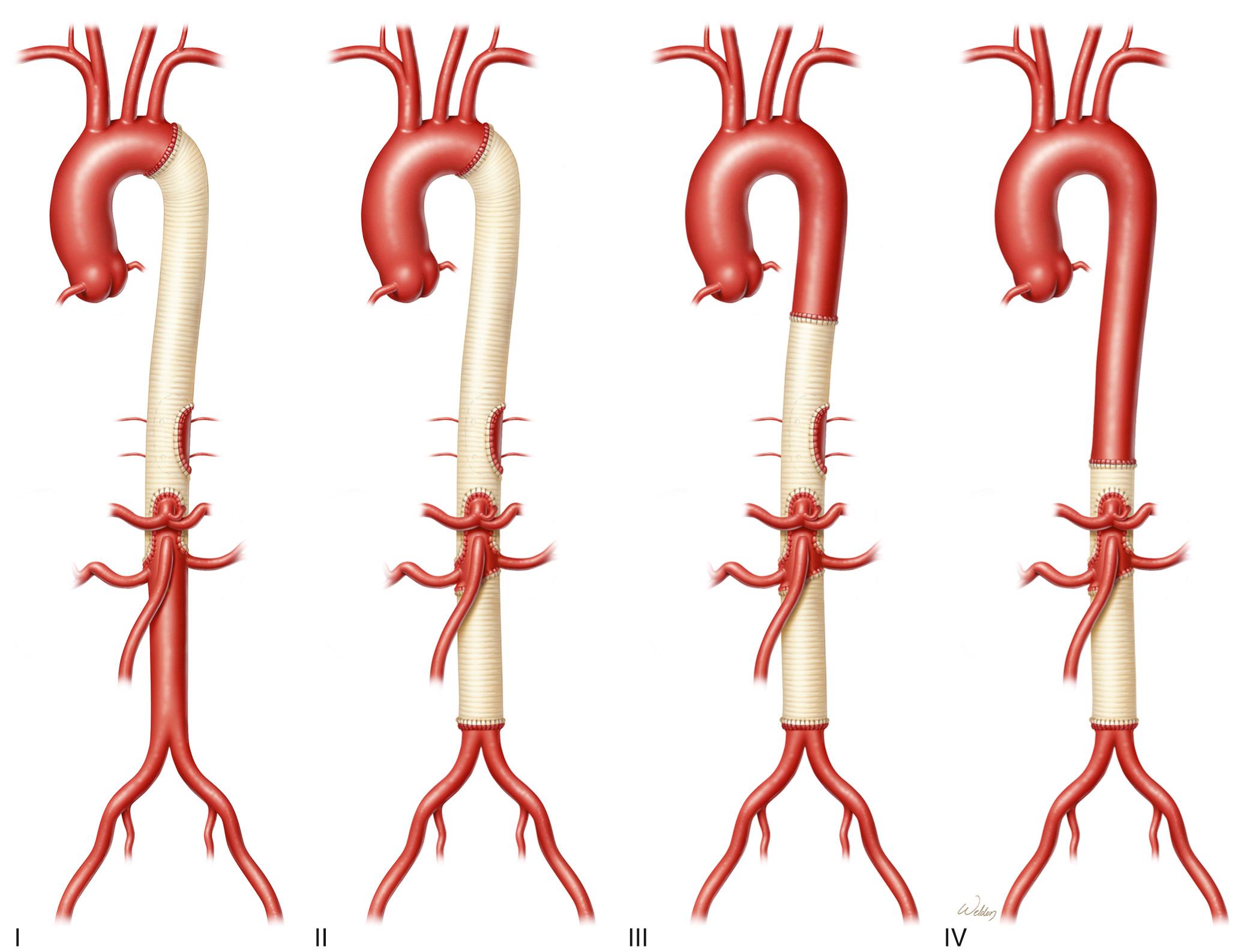
Whereas the aorta expands very slowly in normal circumstances, the distal aorta tends to grow at a faster rate than the proximal aorta. Documented growth rates for the distal aorta range from 0.1 to 0.3 cm per year; growth rates are further increased in larger diameter aortas (8 cm and larger) and in patients with chronic dissection. Elefteriades and his colleagues at Yale identified aortic diameter as a strong predictor of rupture, dissection, and mortality. A critical diameter of 7.0 cm was identified for descending thoracic aortic aneurysms (DTAAs), with a corresponding risk of rupture or dissection of 43%. Saccular aneurysms tend to grow faster and less predictably than do fusiform aneurysms. Although it typically takes years for an aneurysm to reach a diameter-based threshold for repair, many distal aortic aneurysms increase in size and eventually progress to cause serious complications. In addition, as distal aortic aneurysms form, they are commonly lined with substantial amounts of friable, atheromatous plaque and mural thrombus.
Repair of the distal aorta poses substantially different risks than proximal aortic repair. Subsequently, operative strategy and expected outcomes vary with the extent of aortic replacement; generally speaking, risk increases as longer sections of the aorta are replaced. Thus, repair of TAAAs is typically more complicated than repair of DTAAs. Understanding of the extent of aortic involvement is the key to planning an appropriate strategy for operative repair.
Distal aortic disease may be limited to short sections of the descending thoracic aorta, or it may involve long sections of the aorta and necessitate substantial exposure. Aneurysms may begin near the left subclavian artery (LSCA) and extend beyond the level of the diaphragmatic hiatus to include varying segments of the abdominal aorta. DTAAs usually begin just distal to the LSCA and extend toward (but not past) the crura of the diaphragm. Conversely, repair of TAAAs necessitates exposing the aorta above and below the diaphragm and involves incorporating the segment from which the visceral arteries arise into the repair.
The Crawford classification schema conveys useful information about TAAA repair and divides these repairs into four “extents” according to the amount of aorta replaced (see Fig. 69-1 ). Crawford extent I repairs involve the aorta from just distal to the LSCA to the origins of the celiac axis and superior mesenteric arteries and may also involve the renal arteries; however, these repairs do not extend into the infrarenal aorta. Extent II is the most extensive repair and involves almost the entire distal aorta, from near the LSCA to the infrarenal abdominal aorta, and it often extends to the aortoiliac bifurcation; extent II repairs generally incur the greatest operative risk. Extent III repairs involve the mid-descending thoracic aorta (below the sixth rib) and a variable amount of the abdominal aorta. Extent IV repairs begin within the diaphragmatic hiatus and extend through the abdominal aorta. Although some centers use a modified Crawford classification schema that includes an extent V repair, we do not; extent V repairs tend to fall under the extent III category of repair, and these two types of repair typically have similar outcomes.
Although the underlying mechanisms of aortic disease remain unknown, nonspecific medial degeneration is the most common cause of thoracic aortic aneurysms and dissections. Although the fragmentation of elastic fibers and loss of smooth muscle cells are to be expected in the aging aorta, these processes are accelerated in medial degenerative aortic disease and lead to continual weakening of the aortic wall, aneurysm or dissection formation, and eventual rupture. Although atherosclerosis is often construed as a cause of thoracic aortic aneurysms, it may be merely a concomitant condition rather than a distinct cause of aortic aneurysm.
Chronic dissection is a common cause of TAAA; consequently, reported rates range from 15% to almost 40% of TAAA repairs. Aortic dissection (which is more fully covered in Chapters 70 and 71 ) usually begins as a tear in the innermost layer of the aortic wall. This tear allows pulsatile blood flow to cause a progressive separation of the medial layers, thereby creating two channels of blood flow within the aorta ( Fig. 69-2 A ). This process substantially weakens the outer aortic wall, leading to aortic dilation and eventual aneurysm formation. Chronic dissection in the distal aorta occurs in survivors of acute DeBakey type I and III dissection events. Although it is generally assumed that chronically dissected aortas of either type dilate at similar rates, emerging evidence suggests there may be differing rates of expansion between types. Moreover, for incompletely understood reasons, patients with chronic dissection may also develop a superimposed acute dissection; this is a dangerous development, and urgent treatment is warranted.
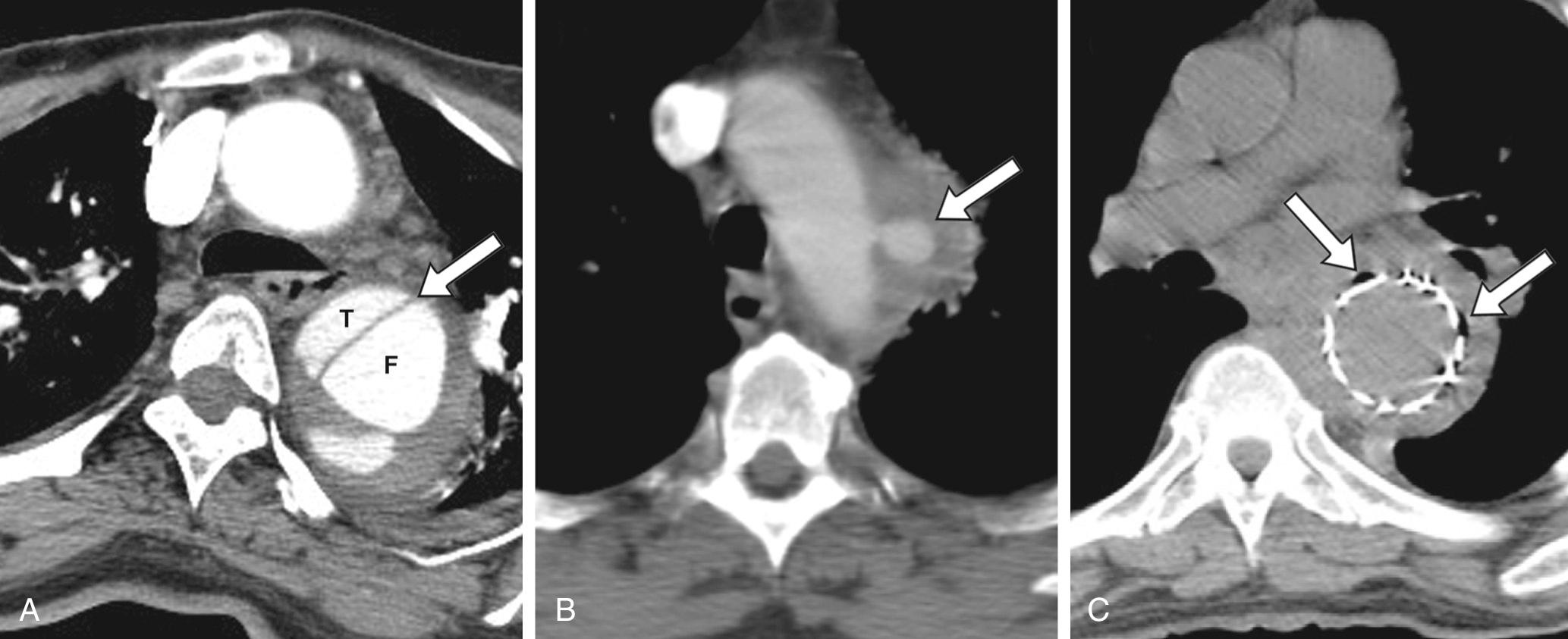
Connective tissue and related genetic disorders occur in 4% to 14% of patients who undergo DTAA or TAAA repair. These disorders range from the relatively well-established Marfan syndrome (MFS) to lesser known, emerging disorders such as Loeys-Dietz and aneurysms-osteoarthritis syndromes. Of these conditions, MFS is the most common in DTAA and TAAA patients; however, surgeons should be aware of the other, more aggressive disorders so as to best formulate individualized strategies for treatment. Most of these syndromes are suspected on the basis of clinical features or a positive family history; as needed, confirmatory genetic tests should be conducted.
Marfan syndrome is an autosomal dominant genetic disorder that predisposes patients to aortic aneurysm and dissection. Although most patients with MFS have a family history of the disease, a substantial number of patients develop the mutation de novo; numerous mutations in the fibrillin-1 gene have been discovered. It was long thought that the presence of abnormal fibrillin in the extracellular matrix reduced the strength of the aortic wall (and thus predisposed the aorta to dilation), but emerging evidence indicates that the abnormal fibrillin alters biomolecular pathways, leading to aberrant signaling of transforming growth factor beta (TGF-β) and a related cascade of events and, ultimately, to degeneration of the aortic wall matrix. The clinical features of MFS usually include a tall and lanky stature with long limbs, eye lens disorders, mitral valve prolapse, joint hypermobility, high palate, and aortic aneurysms in young adults.
Most commonly, MFS affects the proximal aorta, namely the ascending aorta and aortic root. Most patients with MFS who undergo distal aortic aneurysm repair have chronic aortic dissection. Whereas most of these patients are operative survivors of acute DeBakey type I dissection, a substantial number of repairs are done in patients with initially medically managed DeBakey type III aortic dissection.
Loeys-Dietz syndrome is an aggressive aortic disease that tends to affect patients at a much younger age than does MFS. Characterized by widespread systemic arterial tortuosity and aneurysm formation, clinical features include the presence of a bifid uvula or cleft palate and widely spaced eyes (hypertelorism). In the past, many of these patients were identified as having MFS, and like that disorder, this condition is autosomal dominant. However, Loeys-Dietz syndrome is caused by heterozygous mutations in the genes encoding TGF-β receptors I and II. Patients with Loeys-Dietz syndrome require exceedingly careful monitoring because they are predisposed to dissection and rupture at far smaller aortic diameters than are patients with MFS.
Other disorders, such as Ehlers-Danlos syndrome, aneurysms-osteoarthritis syndrome, and nonsyndromic familial aortic aneurysm and dissection, are currently thought to be infrequently encountered in patients who need distal aortic repair. Ehlers-Danlos syndrome comprises a spectrum of disorders of collagen synthesis; the vascular subtype (previously referred to as “type IV”) of Ehlers-Danlos syndrome involves a defect in type III collagen synthesis that lends itself to cardiovascular manifestations, chief among which is spontaneous arterial rupture. Poor aortic tissue integrity tends to complicate surgical repair. Recently identified, aneurysms-osteoarthritis syndrome is an autosomal dominant disorder caused by a mutation in the gene responsible for transcribing TGF-β, SMAD3 . Clinically, this syndrome is reminiscent of Loeys-Dietz syndrome, but, in contrast, these patients also have early-onset osteoarthritis. Of note, these patients have a high incidence of aortic dissection at moderately dilated aortic diameters (4 to 4.5 cm), well below standard thresholds of repair. Several other heritable mutations, affecting families with variable expression, have been documented in the genes for TGF-β receptors, TGF-β 2 , β-myosin, SMAD3, and α-smooth muscle cell actin. Although familial aortic thoracic aneurysms most commonly affect the proximal aorta, such heritable nonsyndromic disease may present as dissection or aneurysm in the distal aorta.
In rare cases, systemic autoimmune disorders, such as giant cell arteritis, Takayasu arteritis, and Behçet disease, may also lead to aneurysm formation in the distal aorta. A granulomatous inflammation may occur in patients with giant cell arteritis (temporal arteritis) that involves the entire thickness of the aortic wall and thus cause intimal thickening and medial destruction. Although Takayasu arteritis generally produces severe intimal thickening that causes obstructive lesions, it can also lead to aneurysm formation. A more common presentation of aortitis occurs when patients with preexisting degenerative aortic aneurysms then develop localized transmural inflammation. Although the reasons for this inflammation remain unclear, its onset can lead to expansion and further weaken the aortic wall. In addition, fibrosis and an infiltrate of plasma cells, giant cells, and lymphocytes can develop in the affected tissue. In Behçet disease, both arteries and veins are affected, and the disease process involves lymphocytic infiltration of the medial layer, which may progress to aneurysm or pseudoaneurysm formation.
In rare cases, infection of the native aorta precipitates distal aortic aneurysm formation. Such lesions are commonly called mycotic aneurysms, even though the responsible pathogens are usually bacteria rather than fungi. Mycotic aneurysms may form as bacteria inoculate healthy aortic tissue, which then contributes to subsequent aneurysm formation, or they may result from the secondary infection of an existing aneurysm. In addition, mycotic aneurysms may be pseudoaneurysms, rather than true aneurysms, and can develop as a late complication of previous iatrogenic aortic injury created during invasive imaging procedures or cardiac or aortic operations (e.g., aortic cannulation sites). Establishing a diagnosis for patients with a mycotic aneurysm can be exceedingly difficult because symptoms can be vague, such as a persistent low-grade fever or unexpected weight loss, and such infection is rare. Further complicating matters, there are a variety of mechanisms by which the source bacteria may infect the aorta; these include vertebral or other abscess, general sepsis or septic emboli, empyema, infected lymph nodes, and other factors that can be difficult to elucidate. Unlike most other distal aortic aneurysms, which tend to be fusiform in shape, mycotic aneurysms are often saccular in shape (see Fig. 69-2 B ) and correspond to localized areas of tissue destruction. Common causative organisms include Staphylococcus aureus, Staphylococcus epidermidis, Salmonella, and Streptococcus, and more than one pathogen may be present. Outside the United States, tuberculosis aortitis may present as saccular aneurysm of the thoracoabdominal aorta, and sometimes even as multiple saccular aneurysms. Of note, saccular aneurysms can be unpredictable, are prone to rapid growth rates, and tend to rupture more readily than fusiform aneurysms caused by medial degeneration; when mycotic saccular aneurysm is suspected, urgent evaluation is warranted.
Over time, late complications of previous distal aortic repair may develop ( Fig. 69-3 ); such complications include pseudoaneurysms and aneurysms that develop around sites of aortic reattachment (e.g., buttons of tissue surrounding reattached visceral or intercostal arteries may later become aneurysmal). In addition, aortic disease may progress such that previously normal sections of the aorta adjacent to the site of a previous repair may later become aneurysmal. Late complications tend to occur more frequently in patients with MFS and other connective tissue disorders and in patients with aortic infection. Overall, distal redo operation (previous open repair of the descending thoracic, thoracoabdominal, or abdominal aorta) rates tend to range from 16% to 27% in reported series of TAAA repairs.
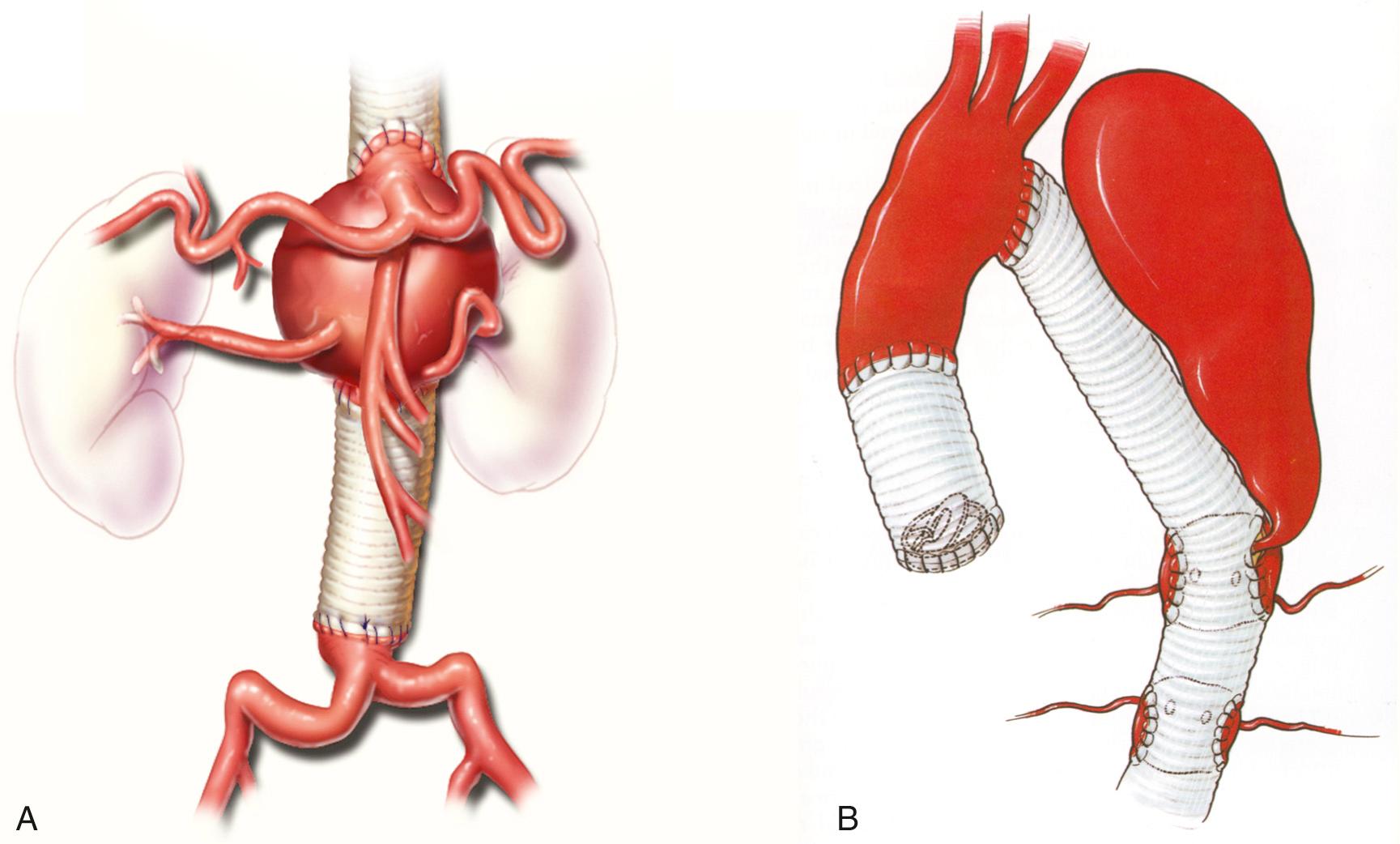
Pseudoaneurysms often represent chronic leaks that are contained by surrounding tissues. The outer wall of a pseudoaneurysm develops from organized thrombus and associated fibrosis. Pseudoaneurysms can arise from primary defects in the aortic wall (such as a leak from a fistula or contained rupture) or from degraded suture lines or graft material (anastomotic leaks were common in the era of silk suture, which readily degraded, and graft infection may also degrade the suture line), from sites of previous cannulation (leaks that occur after cardiovascular surgery), or from a wire penetrating or otherwise damaging the aorta during invasive aortic imaging and testing. Anastomotic pseudoaneurysms can also be caused by tension between the graft and native aortic tissue. With modern suture, graft material, and technique, the incidences of pseudoaneurysm and other late complications have decreased; however, should they occur, urgent evaluation is warranted because they have a tendency toward rupture.
In the contemporary era, the use of aortic stent-grafts in the distal aorta is common in patients with aneurysm and dissection (this topic is fully covered in Chapters 70 and 71 ). Occasionally, patients who have undergone endovascular aortic repair develop problems that necessitate open repair. Open aortic repair after endovascular aortic procedures may be necessary to treat continued dilation of the aorta at or near the stent-graft landing zones, infection of the endograft (see Fig. 69-2 C ), the development of a fistula ( Fig. 69-4 ), stent-graft collapse or migration, or ongoing aneurysm expansion, which may result in rupture. Progressive expansion of the aneurysm may occur because of an inadequate seal between the stent-graft and aorta (type I endoleak), bleeding into the aneurysmal sac from any covered branching artery (type II endoleak), a gap between overlapping stent-grafts (type III endoleak), retrograde perfusion through the false lumen into the aneurysmal sac in patients with extensive aortic dissection, or other causes.
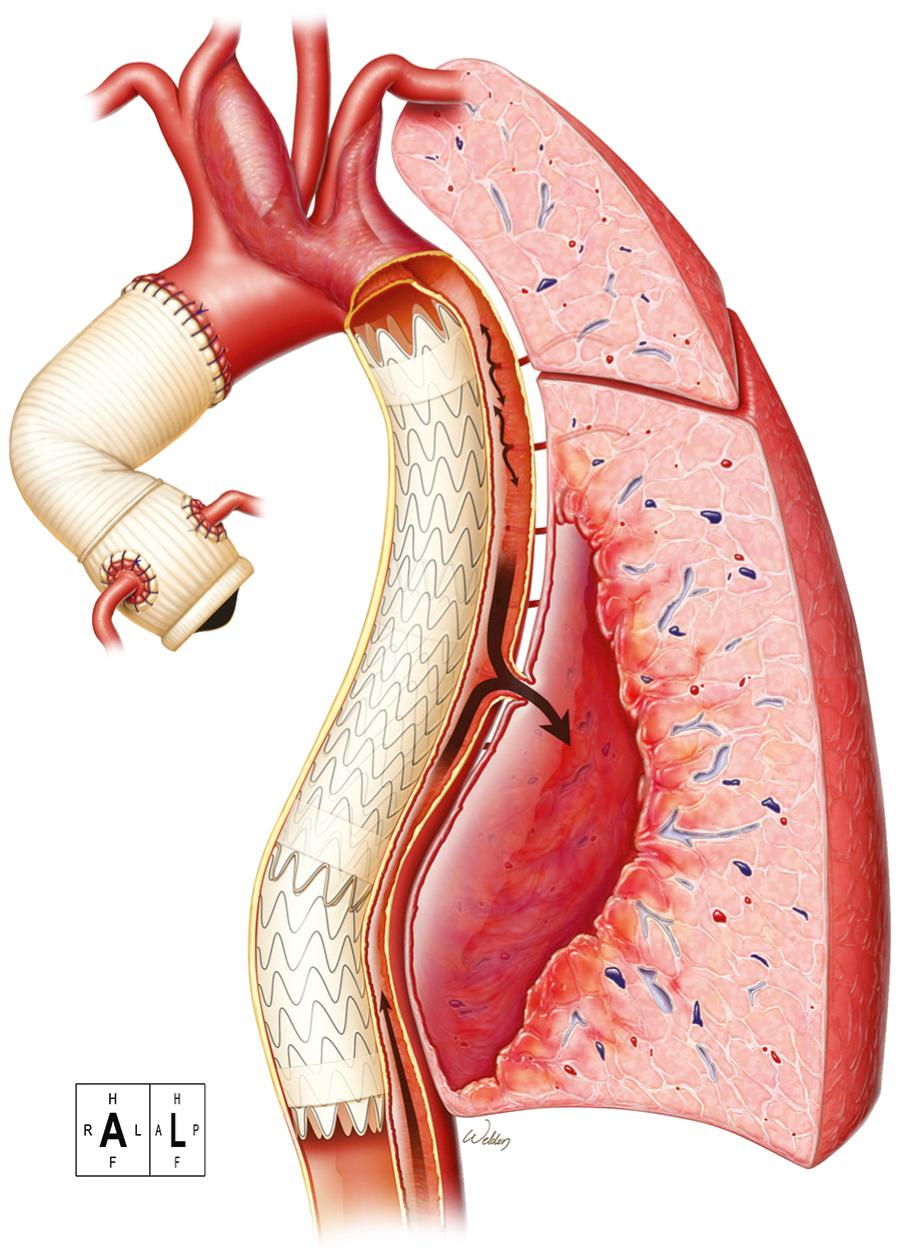
Aortic coarctation may occur in patients with bicuspid aortic valve or other congenital heart disease or in patients with Turner syndrome. The typical presentation of aortic coarctation involves a narrowing of a short section of the descending thoracic aorta, located just beyond the LSCA; the quality of aortic tissue in this section is generally poor because it is delicate and friable. Over the past several decades, several open approaches have been used to treat aortic coarctation in early childhood, including subclavian flap repair, patch aortoplasty, and interposition aortic grafting. In adults, open or endovascular repair may be needed to treat previously undiscovered native coarctation or late complications (aneurysm, pseudoaneurysm, or restenosis) of previously repaired coarctation, which tend to develop in the first or second decade after initial repair. The ideal repair for discrete and previously unrepaired coarctation in adults is somewhat controversial; current guidelines indicate that either an endovascular or an open repair may be performed. In rare cases, adults need primary repair for extreme forms of previously untreated coarctation, such as an interrupted or a hypoplastic aortic arch ( Fig. 69-5 ), or a long-segment aortic coarctation (also known as middle aortic syndrome and sometimes seen with rib notching); for these patients, current guidelines recommend open repair (Class I recommendation, level of evidence B). For patients with discrete restenosis after open repair, endovascular repair is recommended unless significant aortopathy is also present (Class I recommendation, level of evidence B). Today, many experienced centers achieve good results by using a variety of approaches to coarctation repair, including open, endovascular, and hybrid techniques.
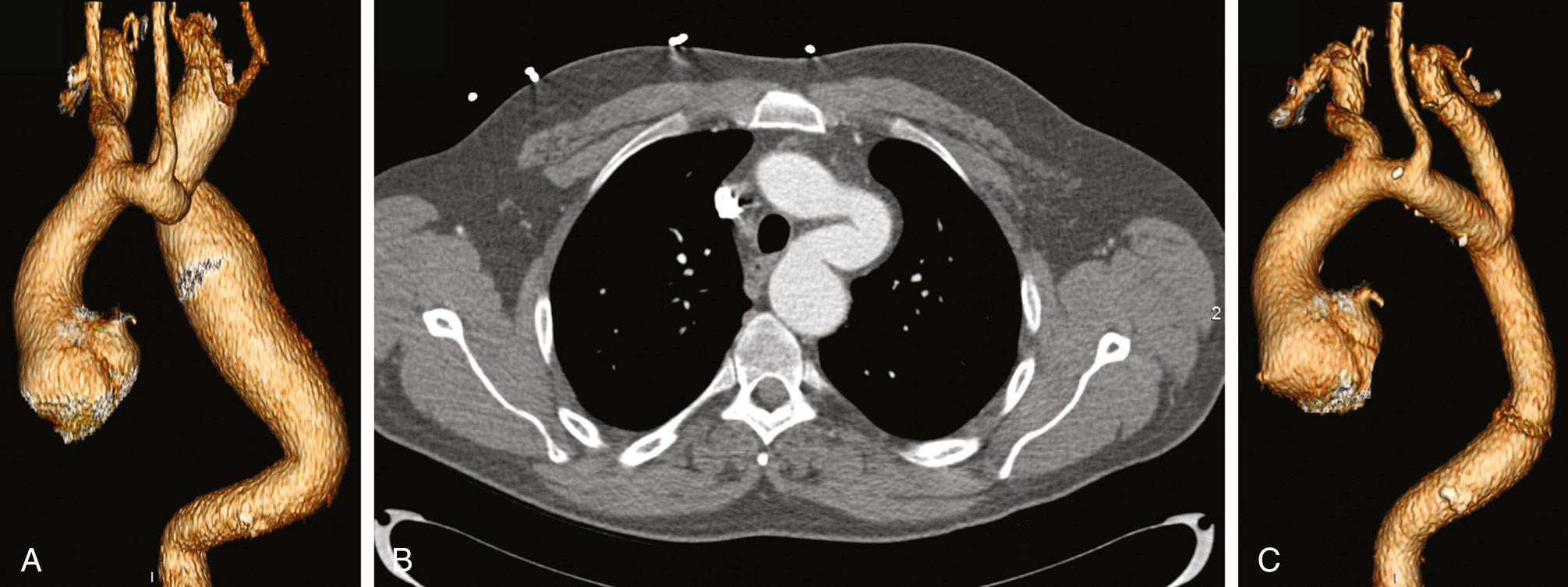
Patients with aortic coarctation commonly have hypertension, and even with treatment, hypertension remains difficult to control. It is thought that uncontrolled hypertension plays a role in the late development of aneurysms, both in patients with previous aortic repair and in those without. In previously untreated adults, extensive collateral circulation may develop; during open repair, these branching vessels may enhance the risk of operative bleeding, and these vessels are commonly ligated when possible. Patients with long-segment coarctation may be treated with extra-anatomic bypass grafts rather than in situ graft replacement.
Descending thoracic and thoracoabdominal aortic aneurysms most commonly present in asymptomatic, older patients (60 years of age and older) and are often incidentally discovered through imaging studies ordered to evaluate other, unrelated health problems. In patients with known risk factors for distal aortic aneurysms (as described in the previous section), imaging studies are used to carefully monitor the aorta until diameter-based thresholds of repair are met or until symptoms develop. Therefore, the management of distal aortic disease is typically dependent on regularly repeated imaging studies and enhanced awareness of emerging symptoms through patient education and optimization efforts (at a minimum, optimization efforts include strict blood pressure control and cessation of smoking).
Although developing an appropriate distal aortic imaging strategy is somewhat dependent on local expertise and equipment availability, recently efforts have been made to standardize image acquisition and reporting by suggesting specific aortic landmarks to measure ( Fig. 69-6 ); for the distal aorta, these include the isthmus or proximal descending thoracic aorta (2 cm distal to the LSCA), the middle of the descending aorta (between the isthmus and the diaphragm), the aorta at the diaphragm (roughly 2 cm above the celiac axis), and the aorta at the origin of the celiac axis. Aortic imaging reports should clearly state the location of aortic abnormalities (using the previously mentioned locations whenever possible) and report the maximum external aortic diameter (reporting the internal lumen diameter may fail to account for aortic wall inflammation, intraluminal clot, or mural thrombus, or identify both channels in cases of aortic dissection). Any extension of disease into branching vessels, such as is possible with chronic distal aortic dissection and other conditions, should be documented. Evidence of rupture should be reported, as well as any identified calcification or internal filling defects that are consistent with thrombus or atheroma. Ideally, results should be compared with the most recent prior imaging study available; precise measurement is needed because the yearly rate of aortic expansion is generally quite small, and thus, detecting a small but abnormal growth rate can be challenging.
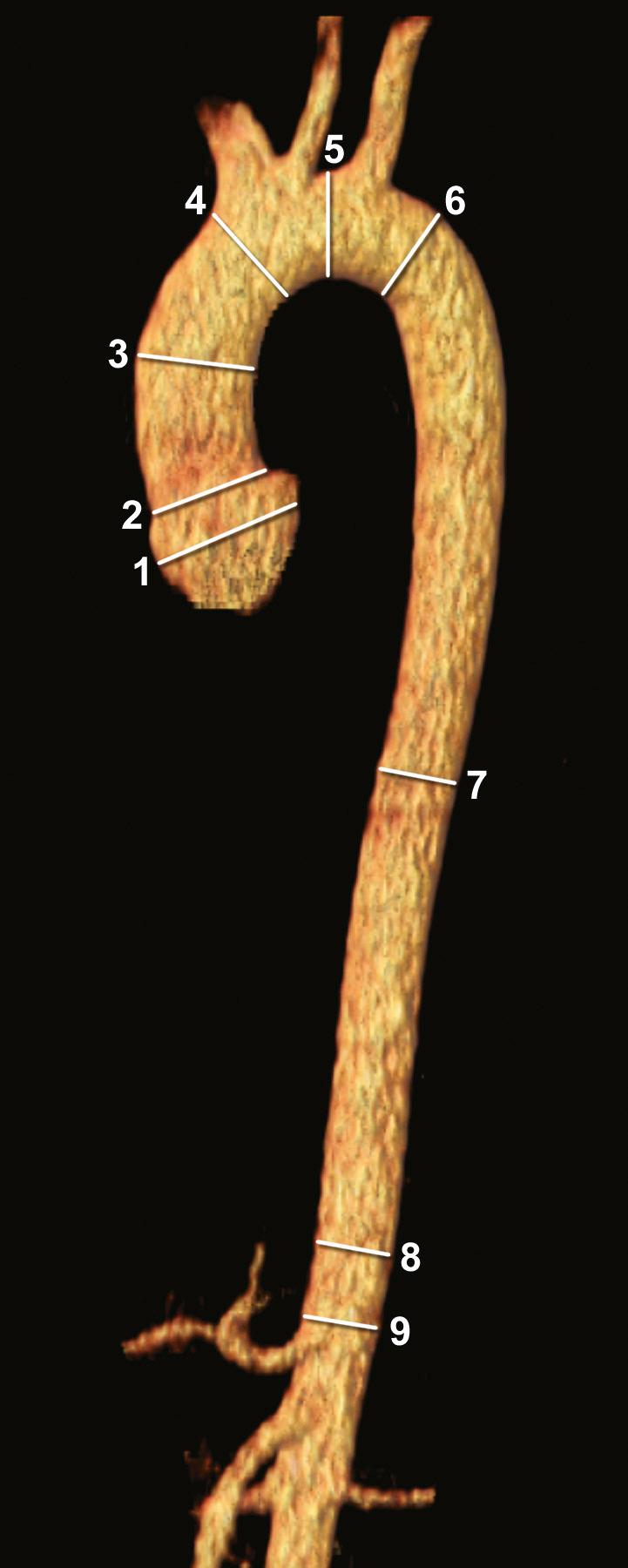
Although a routine chest radiograph may suggest an aortic abnormality, the most useful diagnostic imaging modalities include computed tomographic (CT) and magnetic resonance imaging or angiography scans of the chest and abdomen to delineate the extent of aortic and branch-vessel involvement. Since the CT was first reported to identify aortic disease in 1976, it has become widely available and is the most commonly used imaging modality for identifying aortic aneurysms. Information about the aneurysm's location and extent, external diameter, the presence of aortic dissection, the relationship to branching vessels, and anatomic abnormalities are all readily provided by iodinated intravenous contrast-enhanced CT imaging ( Fig. 69-7 ). Such imaging may also aid in determining the presence of aortic infection, because nearby gas bubbles can be readily identified. Benefits of CT imaging include the short time needed to acquire the imaging data, the ability to render three-dimensional imaging, and the ability to provide multiplanar evaluation, as well as locating the presence of any aortic calcification or thrombus. Disadvantages of contrast-enhanced CT scanning include repeated exposure to ionizing radiation and the possibility of contrast-induced allergy or contrast-induced acute renal dysfunction in patients. Whenever possible, surgery is performed at least 1 day after contrast administration to allow time to observe renal function and, if needed, to permit renal function to return to normal.
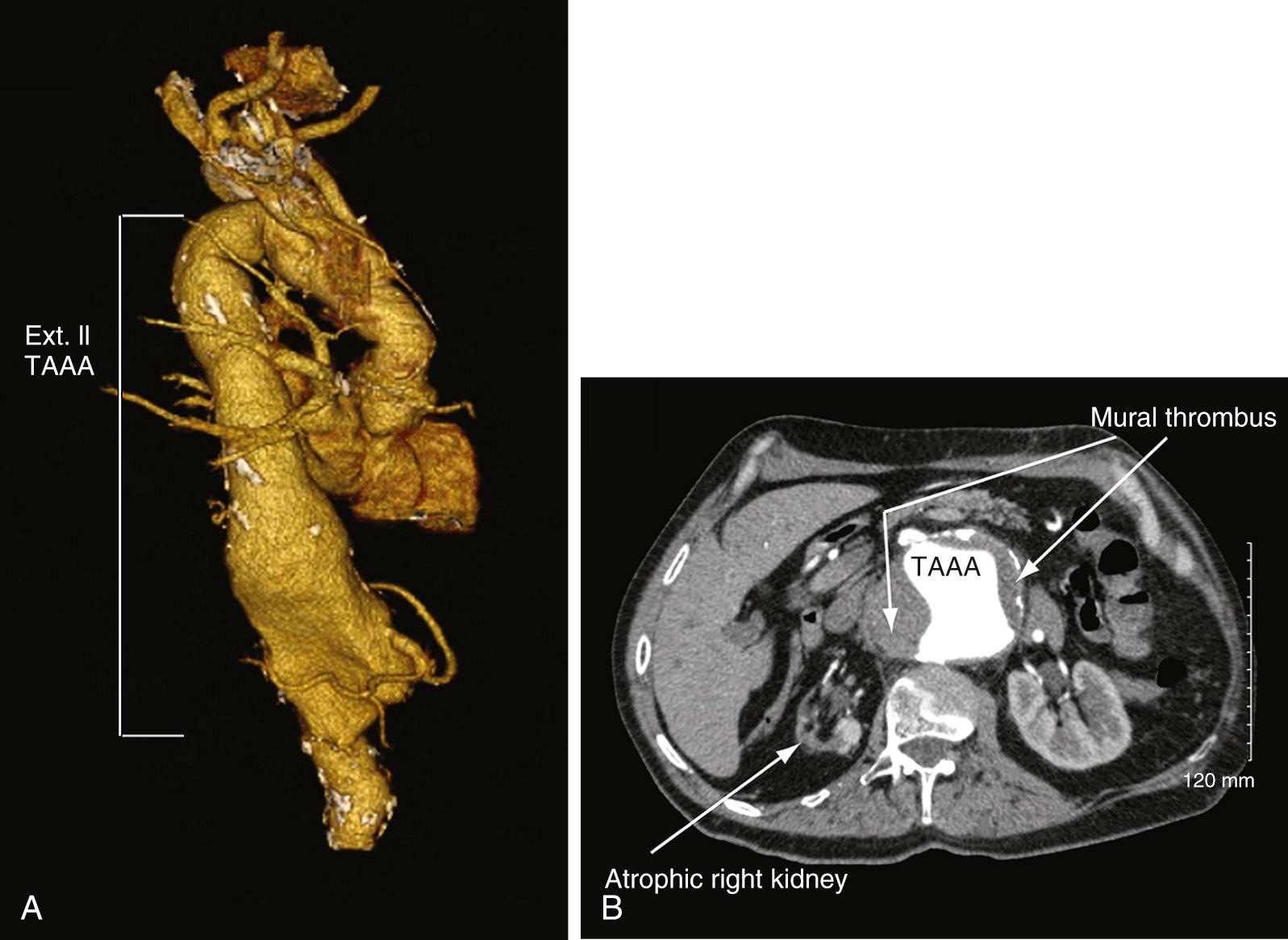
Although magnetic resonance angiography (MRA) is not used as commonly as CT imaging to detect aortic aneurysm, it produces comparable or better aortic images and does not expose patients to ionizing radiation. It offers excellent visualization of all facets of branching vessels and facilitates the identification of left ventricular dysfunction. Disadvantages of MRA include the generally higher expense, the extended time needed to acquire imaging data (which poses a challenge in the critically ill patient), the suboptimal identification of aortic calcification, and the generation of artifacts created by ferromagnetic materials (such as pacemakers and other implants). In addition, the contrast agent for MRA, gadolinium, is associated with nephrogenic systemic fibrosis in patients with comorbid renal dysfunction. In young and otherwise healthy patients, such as those with MFS, MRA may be a valuable supplement to lifelong surveillance imaging because it avoids exposure to radiation. Echocardiography and ultrasonography are not used to evaluate DTAAs because these techniques cannot adequately visualize disease involving this segment.
All aneurysms are repaired to prevent fatal rupture. Although replacing the aorta can be life-saving in patients with aortic disease, surgical intervention carries substantial risks for both morbidity and mortality. Because of the inherent risks associated with surgical intervention, surgery is generally indicated only when the risk of rupture or other catastrophic aortic complications exceeds it. Studies of the natural history of distal aortic aneurysms (as described in a previous section) helped to formulate diameter-based thresholds of repair in asymptomatic patients. Current practice guidelines recommend elective open aortic repair in asymptomatic patients when the diameter of a TAAA exceeds 6.0 cm; a lower threshold is recommended if the patient has a connective tissue disorder (Class I recommendation; level of evidence C). In patients with chronic aortic dissection, elective open repair is indicated when the descending thoracic aorta exceeds 5.5 cm (Class I recommendation; level of evidence B). Although not expressly recommended for the distal aorta, elective repair of the proximal aorta is recommended when the rate of dilation exceeds 0.5 cm per year; it is reasonable to follow this recommendation in distal aortic repairs also, because such rapid growth indicates an unstable aneurysm.
When specific symptoms are present, they are usually related to aneurysmal expansion and compression of surrounding structures or to malperfusion related to aortic dissection. The onset of symptoms is usually considered an indication of impending rupture or significant malperfusion and should prompt urgent evaluation. Pain, the most common symptom, may be located in the chest, back, abdomen, or left flank; it may be described as a sharp or stabbing acute pain or as refractory pain. However, pain may be chronic and the cause poorly understood in these typically older patients.
Myriad other symptoms can arise, and whenever possible, a careful medical history should be obtained from each patient. In rare cases, fistulas can develop in patients with distal aortic aneurysm, and unexplained bleeding may be present. Dysphagia can result from compression of the esophagus, whereas coughing, wheezing, or pneumonitis can result from impingement on the trachea or proximal bronchi; hemoptysis may result from erosion into these structures. Hoarseness may result from partial vocal cord paralysis if the recurrent laryngeal nerve is compromised. Pressure from expanding aneurysms can erode spinal bodies (often resulting in pain) or the bowel wall (causing gastrointestinal bleeding). Duodenal obstruction may occur through related compression. In rare cases, jaundice can result from compression of the biliary tract. Compression of the inferior vena cava or iliac vein can result in distal venous stasis and can present as an abdominal bruit, with widened pulse pressure and edema, and may result in heart failure.
Additional symptoms related to embolization, frank rupture, or either acute-onset dissection or expanding chronic dissection can result. Plaque and thrombus may embolize distally, causing occlusion and thrombosis of the visceral, renal, or lower extremity branches and subsequent malperfusion. Shock, refractory hypertension, or rapid aortic expansion may indicate existing or pending rupture; DTAAs tend to rupture into the pleural cavity, often resulting in severe hemorrhagic shock. Spontaneous paraplegia; abdominal pain; cold, blue, or painful extremities; nausea; vomiting; and incontinence or abnormal urination can be signs of malperfusion caused by aortic dissection.
The assessment of possibly aneurysm-related symptoms is essential to developing an appropriate management plan. Patients who develop symptoms undergo surgical repair regardless of aneurysm diameter. The most common indication for emergent repair of a TAAA is aortic rupture or an acute dissection superimposed on an existing chronic dissection; often such dissection rapidly progresses to aortic rupture. Although emergent repair is well understood to carry greater operative risk than does elective repair, any inappropriate delay of repair risks death; appropriate delay includes transfer to an experienced center.
Become a Clinical Tree membership for Full access and enjoy Unlimited articles
If you are a member. Log in here